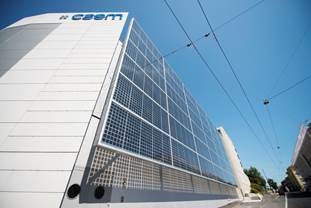Sep 4 2015
Today, in the center of Neuchâtel, the municipality, Viteos, and CSEM inaugurated a photovoltaic (PV) façade that catches the eye with its ultra-modern design and combines innovative technologies. This robust, energy-efficient, and highly attractive facade marks a turning point in the architectural integration of PV panels in Neuchâtel, paving the way for modern and attractive solar architecture.
 PV Solar Façade
PV Solar Façade
Built with new solar panels developed and manufactured entirely in Switzerland, the new south facade of the building located at Rue de la Maladière 83 is the result of the decisive support received from several of CSEM’s partners committed to renewable energies. Besides the technological and energy benefits, the construction stands out because of its architectural integration. The photovoltaic screen—semi-transparent to lend it an airy and elegant look—was designed by the Neuchâtel-based architectures GD Architectes, jointly with CSEM’s PV-center, which selected the technologies used.
Sustainable urban development and commitment to renewable energy
Above all else, it was the commitment of Viteos and the City of Neuchâtel that resulted in the facade being built. As the leader in renewable energies in the Neuchâtel region, Viteos has confirmed its ongoing commitment to the sector through its adoption of an investment program that will see it spend EUR 24 million over 10 years on photovoltaics. The Neuchâtel-based firm is particularly proud of having employed these innovative technologies for a building frontage. "Photovoltaic systems have become a fully fledged component of buildings and the use of solar panels for enhancing building aesthetics is making this renewable energy source a familiar feature in the construction field", Josette Frésard, Viteos’s Managing Director, points out. For his part, Olivier Arni, Neuchâtel City Councilor, emphasizes that that this exemplary construction is part of the urban development of the Maladière/Jaquet-Droz area. "This construction is perfectly in line with our policy for sustainable urban development. It will showcase the excellent competencies we have here in Neuchâtel and establish the city as one geared toward innovation and the integration of renewable energies."
Successful transfer of innovation to an industrial partner
The photovoltaic modules used are composed of high-efficiency bifacial solar cells, also known as solar cells based on heterojunction technology (HJT), a forward-looking technology developed entirely in Neuchâtel by EPFL's PV Lab and CSEM's PV-center. This advanced technology was transferred to the Meyer Burger Group, which currently produces systems for manufacturing both bifacial cells and bifacial modules, combining heterojunction technologies with solar cell interconnection technology (SmartWire Connection Technology). "Switzerland has to play its part in the race to produce powerful renewable energy systems. The potential these technologies offer is extremely high not only for solar parks but also in the built environment, combining both aesthetics and maximum power generation", explains Christophe Ballif, Director of the PV-center at CSEM.